In May 2023, a month after the ‘Train depots for today and tomorrow’ conference (see page 26), Rail Partners and Rail Delivery Group hosted a fleet introduction and cascades lessons learned event. Around 8,000 new vehicles, not all yet in service, were ordered by many operators in the 2010s. This resulted in the cascade of older vehicles to other operators. With such a big programme, some problems were inevitable.
Mark Molyneux, national fleet performance manager, Rail Delivery Group (RDG), set the scene, discussing the well-publicised problems of the May 2018 timetable. This debacle put the rail industry’s problems into sharp focus and the delay to fleet introduction kept rail in the headlines. He reported that the biggest cause of delay to the industry Public Performance Measure were ‘fleet related’ issues. Fearing that the influx of new trains would cause further harm, RDG commissioned the report ‘Risks to Network Performance from New Train Introduction’.
This report sought to address the questions: Is there a risk to system performance from unreliability of new rolling stock? Is there a risk to timetable delivery from late introduction of new and refurbished rolling stock? The report identified factors increasing these risks and proposed actions and mitigations to ease the short-term situation and make major improvements for later projects. Mark reported that the output from an RDG-convened New Trains Colloquium in October 2018 and the above report led to the development during 2019 of the RDG Guidance Note ‘New Trains – A Good Practice Guide’ that was first published in March 2020.
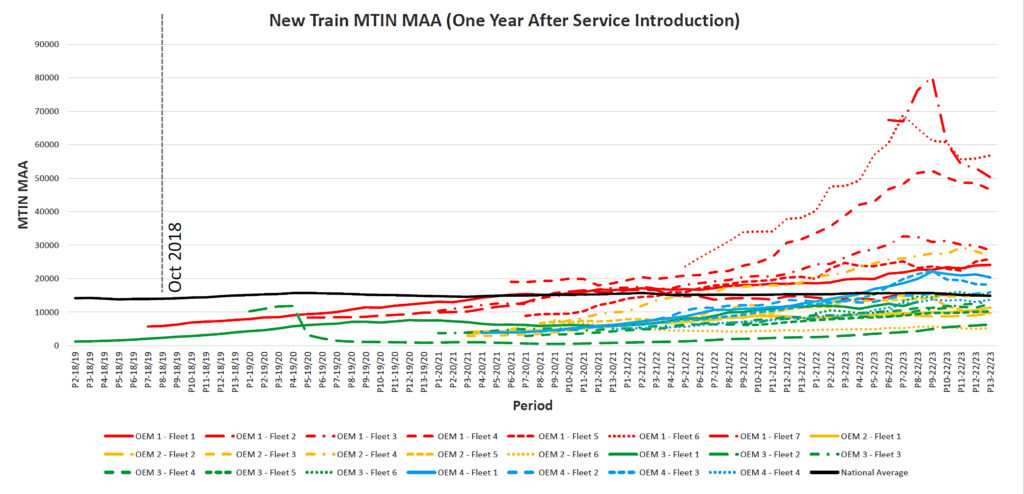
Mark reported that, despite this worry, the average Miles per Technical Incident (MTIN) has remained remarkably consistent since 2018. He had also examined the growth in MTIN performance over the first year in service for each new fleet introduced since 2018. Some fleets have achieved MTIN significantly better than the national average, whilst others have delivered slower reliability growth. See Figure 1.
The difference between suppliers is significant. One supplier’s fleet exceeded the national average MTIN in 15 months from entry into service, whilst another took over 54 months for just one of its fleets to pass the average MTIN figure. See Figure 2.
Of course, the context of each fleet varies and there are differences between new designs, duty cycles, and follow-on orders for established designs.
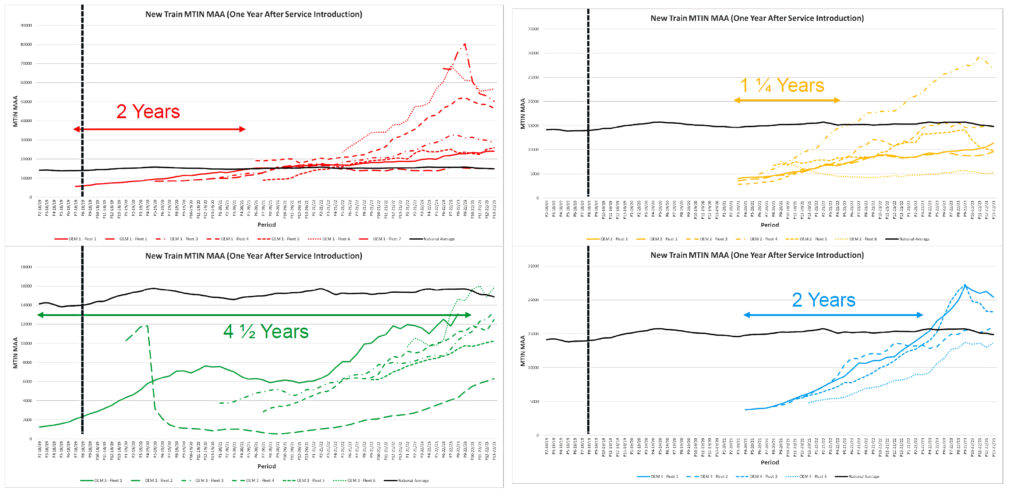
Collaboration
Steve Clarke, senior project manager at Angel Trains, described a collaborative project with Hitachi in which 19×5-car trains were supplied to TransPennine Express (TPE) and 5×5-car trains were supplied to Hull Trains, both financed by Angel Trains. They were ordered in October 2016 and delivered in 2019-20. Although similar to the class 802 units supplied to GWR, these have a larger fuel tank, higher output engine, bigger rheostatic brake, and a revised catering area. The bodyshells were to be built and painted in Japan, and assembled in the UK, but, in fact, seven units were fully built in Japan, the remainder assembled/finished at Hitachi’s plant in Pistoia, Italy, and all were commissioned at the UK plant in Newton Aycliffe.
Steve said that the collaboration was grounded on these key behaviours: a shared sense of success, a shared fear of failure, relying on each other, and holding each other accountable.
“If everyone performs well, we will all succeed…but if one fails, we all fail,” said Steve. He added that trust in each other was essential. Steve told the audience that part of the success was to give the contract a voice and understand what it was trying to accomplish.
People tend to focus on the parts of contracts that emphasise procedures if things go wrong, but Steve stressed the importance of maintaining a preventative mindset, as well as collaborative behaviours when corrective action was needed.
A joint risk register of project risks (which focused on things that might throw the project off course rather than financial or safety risks) was in place, with mitigation activities managed by the organisation best placed to do so. For example, TPE and Hull Trains managed gauging. A similar approach was taken for other interfaces, with one organisation in the lead but the others having actions.
Collaborative project management works, as Steve concluded. It requires hard work and care, but all must want to work together. As one delegate put it: “you can’t collaborate at someone”.
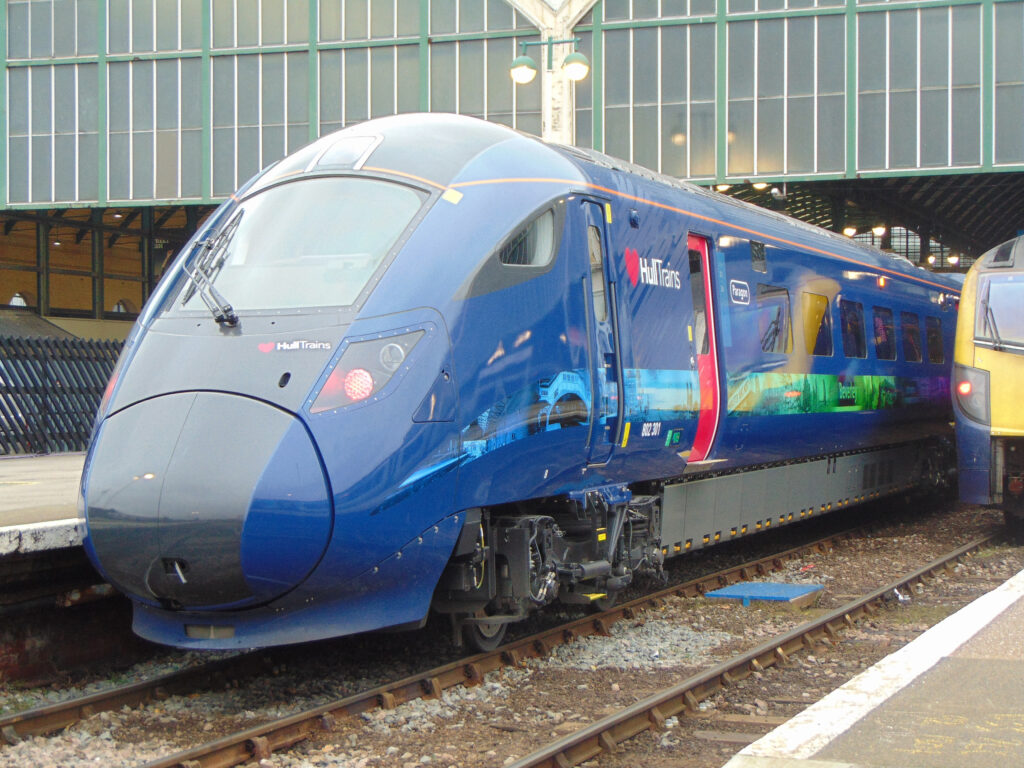
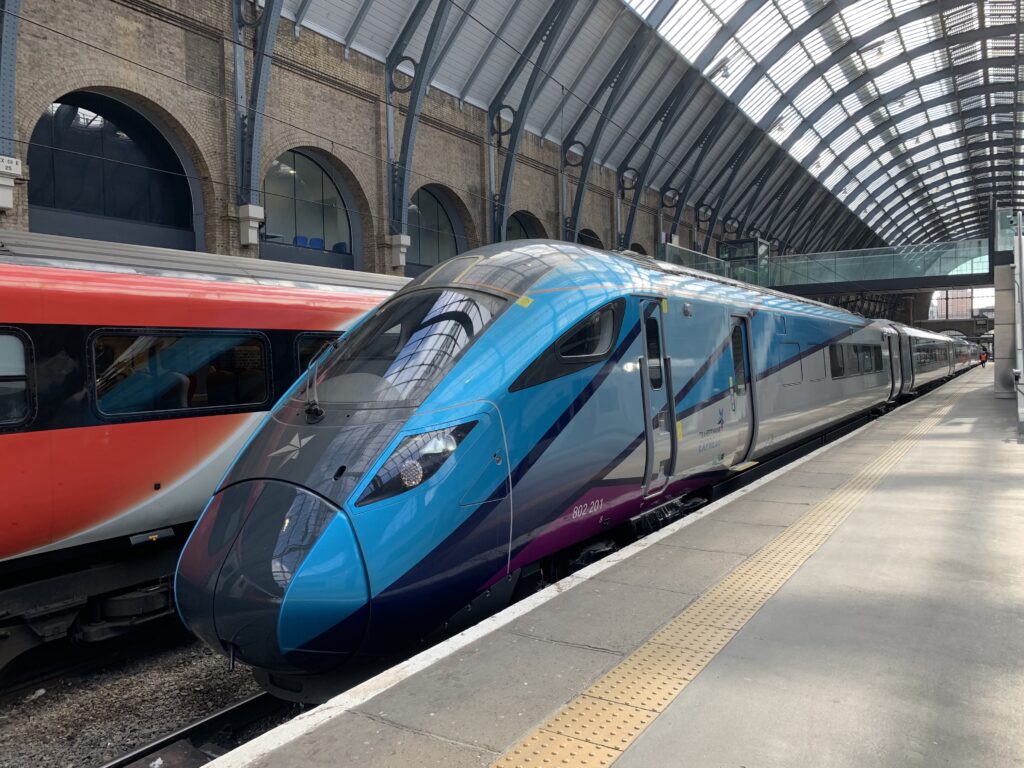
All change
Martin Beable, engineering director at Greater Anglia (GA), talked about the pitfalls of introducing their new trains. GA’s 2016 franchise agreement provided for the then current fleet to be replaced by Alstom Class 720 and Stadler Classes 745 and 755 units. The original plan showed that all these would be in service by the end of 2020 but there were delays, mostly caused by Covid. Martin showed the actual timeline and reported that the last of the legacy fleet had now been withdrawn. Another change was to make the suppliers responsible for maintenance, with many staff transferred to them under TUPE, and depots had to be extensively rebuilt as discussed in the Depots article elsewhere in this magazine.
The split of responsibility between GA and the suppliers was slightly unusual, as shown below.
Martin stressed the importance of constant reassurance for staff who knew they were to be transferred up to five years before the event happened. Martin described a lesson learned from Norwich Crown Point depot. Although both GA and Stadler personnel were on site and strategy and responsibilities had been set out clearly in contracts, physical and cultural walls made meaningful collaboration difficult, and silos emerged. Martin commented that in practice, the contract did not cover all situations and was too commercially led. GA and Stadler implemented joint initiatives, which should have been in place from the start, with a one team approach under a ‘putting the passenger first’ banner.
Possibly the biggest challenge of all was capacity, particularly during the Stadler FLIRT fleet introduction. Martin said that Stadler was delivering as fast as it could, but, while the depot was managing commissioning and cascades, capacity was reduced while the site was rebuilt and there was nowhere to put the new trains. In addition, there was only three months of overlap between receiving new trains and handing back the old ones, leading to last minute deals with ROSCOs and the train operators who were supposed to be receiving the cascaded fleets. This led to the most important and frequently revised working document, the fleet cascade plan, and the weekly cascade meeting.
Martin gave his own mental scoresheet for the transition in exam style, resulting in an overall ‘pass’ mark for their new fleet introduction.
Fleet cascade
Neil Bamford, fleet director at East Midlands Railway (EMR), turned to the subject of fleet cascade. This was not unlike GA, where eight different fleet types become three but, for EMR, only one fleet is new. The incoming fleets were the Class 360 from GA and 2- and 3-car Class 170s from Govia Thameslink Railway, West Midlands Railway, ScotRail, and Transport for Wales. In addition, as stopgaps before the Hitachi Class 810 units arrive, EMR’s HSTs were replaced by redundant (but more compliant with the NTSN for People of Reduced Mobility) HSTs from LNER and ex-Hull Trains Class 180s. Outgoing Class 15x units were cascaded to Northern or are going off lease.

To add to the mix, EMR was working with four ROSCOs (Angel, Eversholt, Porterbrook, and Rock) and a huge amount of legal documentation was involved, including 15 leases, six sub-leases, and literally hundreds of extensions, amendments, side letters and associated documents, handover/hand back documents, conditions, and liabilities. This task alone was time consuming and expensive, with each ROSCO having a different approach.
While all this was going on, performance had to be maintained. For the cascaded units, timely technical and traincrew training needed to be undertaken, tools and equipment put in place, technical documentation needed to be accurate and understood, and a float of material obtained. In addition, said Neil, depot capacity and throughput was a challenge and delayed refurbishments, such as Class 360, didn’t help.
One might think, mistakenly, that all the Class 170 units transferred in to EMR would fit easily with the existing fleet. Besides obvious things such as livery and pre-recorded announcements, there were all sorts of differences – see table below – some of which could be corrected quickly and others which took longer. In the meantime, trains still had to be brought into use.
To mitigate risks, train and fleet staff visited Selhurst, Tysley, and Cardiff Canton to see and understand the configuration of the various units. Despite that, differences between inherited fleets have caused operational incidents. Extensive briefs were provided to mitigate further risks and safety validation panels have been held.
Neil reported that introducing the Class 360s was relatively straightforward, partly because they were to operate a new service. A sub lease was put in place with sister company GA and Siemens remained as maintainer (under a new TSA contract). Initially, only 14 from 21 units were required and reliability has steadily grown. Two big issues are the outstanding refurbishment and provision of maintenance facilities. There has only been limited upgrade work at Bedford Cauldwell depot and units still need to be loco hauled to Northampton, Kings Heath once or twice per week. But further upgrades at Cauldwell are due to be complete by August 2023 (overhead crane, lifting jacks etc.) to reduce the reliance on Kings Heath.
In summary: the ever-changing plan had knock-on effects to internal resource and the supply chain. Neil said that there must be clarity and trust about handover and hand back. He also wondered whether contractual process and methodology need to be so complex?
From speed limit signs to coffee pots
Returning to new trains, Liam Hockings, new fleet introduction manager at Avanti West Coast, covered the multitude of issues to be dealt with when a new fleet is being introduced. He identified 69 separate activities, with assurance, training, and compatibility representing a minority of the activities.
The Classes 805 bi-mode and 807 electric Hitachi Inter City Express trains are nearly standard units, but they are new to Avanti and all staff using them will require training including maintenance staff from Alstom.
Moreover, as non-tilting units, they will currently be limited to 110mph on the fast lines. Avanti and Network Rail are working on the Multiple Unit (MU) Line Speed Enhancement project, to maintain route capacity with non-tilting trains. Liam said that there will be no physical track works, just new signs showing, for example, ‘MU 125’, and detailed planning is ongoing to integrate the driver training required for the new trains, the new speed profile, and the introduction timetable whilst maintaining the train service. The work also includes a detailed risk assessment to understand and mitigate the risks associated with operating a mixed fleet with potentially different means of managing the safe speed of the train.
Liam outlined the validation work to show that 42 stations with over 200 platforms, many shared with other fleets/operators, were ready for the new trains but this was complicated by three different train lengths being introduced, and the positions of multiple wheelchair, cycle, and catering doors needed to be considered for all train formations. Liam said that 30 miles of walking with a measuring wheel was required to complete these assessments.
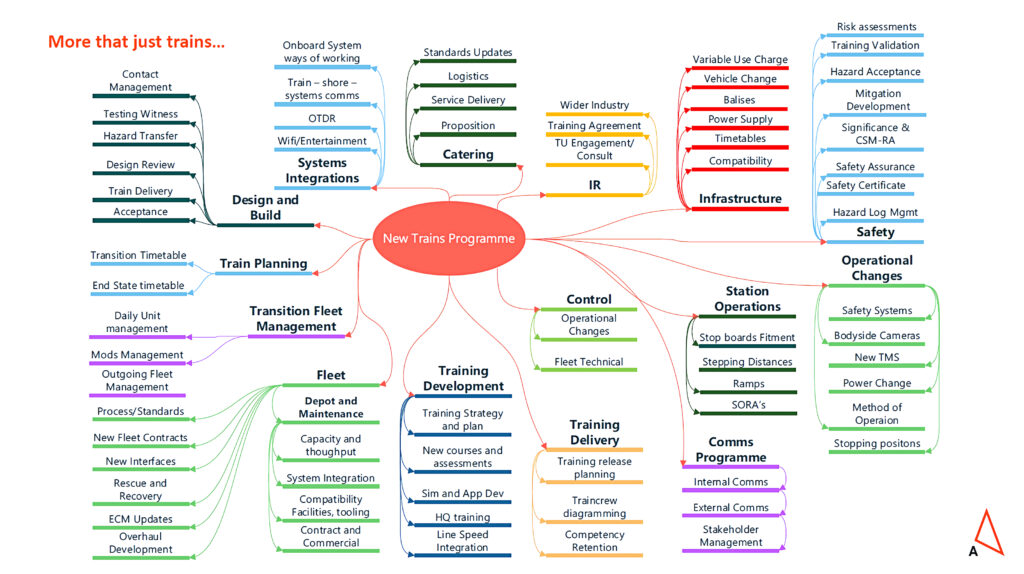
Station stop signs are an issue, with some locations needing many. At Milton Keynes Central, for example, the two operators will be operating trains from three cars to 12 cars with lengths between 72 and 265 metres. Another consideration was signalling, e.g., making sure trains don’t stop with a wheelset over an axle counter. Liam reported that validating the catering vehicle layout is more complicated than one might think. Issues include: does it meet the expectations, has the catering offer changed since the train was specified, do the coffee pots fit and are the chillers big enough for a reasonable stock of sandwiches?
Compatibility and safe integration
New trains affect Network Rail infrastructure, of course, and might have an impact on other operators’ activities. Organisations introducing new trains into service or moving existing trains to a new route have several legal duties to undertake including demonstrating compatibility with the lines on which they will run.
David Galloway, network technical head for System Compatibility and Traction & Rolling Stock, Network Rail (NR), outlined some of the issues. Duty Holders (i.e., Train Operator for trains, NR for, e.g., new stations) must demonstrate their changes are safe, comply with relevant international, national and railway specific standards and are compatible with the rest of the system, though, in general, fleet cascades generally need only consider compatibility.
Considering new trains, train operators sometimes delegate responsibility for some of the work to the train supplier. Network Rail also must satisfy itself that trains are compatible with its infrastructure, so it is important that organisations collaborate, a process, David said, best started early with open dialogue between affected parties. Railway and general health and safety law imposes the duty of cooperation between Duty Holders, but to make the railway work, there must also be cooperation with ROSCOs, manufacturers, neighbours and others who are not specifically identified in the law.

Whilst there is plenty of guidance on what factors to consider, there cannot be a definitive list. David cited 24 relevant Group and Railway Industry Standards that usually need to be considered. Key topics include power, signalling and train protection, gauging, acceleration/braking curves, track wear, selective door operation and electromagnetic compatibility.
As well as demonstrating compatibility, duty holders have to demonstrate safe integration; making sure that a change (e.g., a new vehicle type, network project, subsystem, component, software, procedure, organisation) fits into, and does not create an unacceptable risk for, the resulting system.
Looking to the future
Rich Fisher and Maria Cliff, from the Great British Railways Transition Team looked at future rolling stock, depot, electrification and decarbonisation strategies. The aim is for the fleet strategy to contribute to the five key strategic options for rail: economic growth, meeting customers’ needs, environmental sustainability, financial sustainability and levelling up/connectivity.
Rich said that the Traction Decarbonisation Network Strategy recommended approximately 13,000 single track kilometres of electrification. He said that it would be wise not to assume that this plan is the only solution. He said that a balance of rolling stock and infrastructure solutions will be necessary, and he anticipated that rail will need to use offsetting and bio-fuels to demonstrate net zero carbon beyond 2050. That said, electrification scenarios have been tested representing different levels of capital investment on a ‘no regrets’ basis (i.e., still worthwhile even if the cost of electrification, affordability, and technology assumptions change.) He illustrated the strongest case where some 18% of the unelectrified network is wired. This included Felixstowe northwards avoiding the East Coast main line, Cardiff to Swansea, GWR to Bristol and Westbury, parts of the Chiltern line to Birmingham with a connection to Didcot, as outlined in red on the adjacent map.
“This is based on sections where electrification is the clear solution, with further decisions deferred until affordability and technology development become clear”, he said.
Rich presented a graph showing what type of traction might replace the diesel fleet over the next nine control periods (45 years). This programme would see the virtual elimination of diesel only passenger trains but would retain a significant number of bi-mode diesels (or other fuelled internal combustion engine). He said that hydrogen has limited role, due to cost and energy density, but this could be revised if technology develops. He added that electric passenger trains outperform diesel which brings carbon gains through modal shift and benefits all customers whilst delivering lower operating and maintenance costs.
Rich’s views on trains for the future focussed on improving from the short termism of specifying new trains to win a franchise. He added that the supply chain has been getting inconsistent messages from the industry, hindering investment in innovation, and increasing costs. He wants the emerging strategy to consider trade-offs and choices (e.g., seats vs luggage vs bikes) and to quantify them where possible. There will be a vision to help the supply chain deliver for both funders while meeting the needs of passengers, but the strategy will not be about designing new trains, more it will be about linking the long-term strategy to existing good practice.
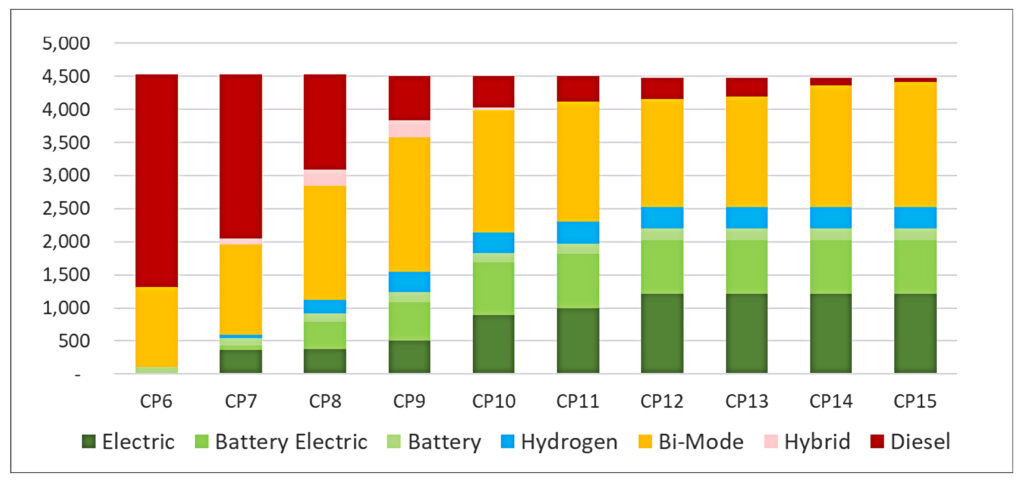
Maria considered some near-term decisions required, specifically the ‘legacy’ DMU fleet (Classes 150, 155/6, 158/9, 165/6) which are nearing life expiry. Although some operators have begun to engage with the market for replacement trains, she said “a network-wide vision will help support individual operators and ensure best value decisions”. That said the default position is that most replacements will be diesel powered or, in a small number of cases, batteries. Options being evaluated include bringing younger off lease diesel trains back into service, selective life extension to defer replacement, and/or accelerate deployment of battery trains (new or upcycled) to low-risk routes.
Maria and Rich expect that with better planning and more homogeneity, trains might be introduced more efficiently.
Conclusion
For your writer, key messages from the event included: introducing a train fleet isn’t just an engineering challenge, it’s a major business change programme for the operator and others in the industry. As Liam Hockings said, new trains don’t put themselves in service, people do, and the importance cannot be overemphasised of detailed planning and investing the time to build open and honest, collaborative relationships between operators, manufacturers, rolling stock owners and infrastructure managers so challenges can be shared and solved.
Finally, there are still over 1,000 vehicles from the pre-2020 orders to place into service and this means that there is still plenty of opportunity to apply lessons learned here and from the RDG Guidance Note: New Trains – A Good Practice Guide.
Thanks to Mark Molyneux of RDG and Neil Ovenden of Rail Partners for the opportunity to attend and report this industry event. Photos and other illustrations provided by presenters unless otherwise stated.

